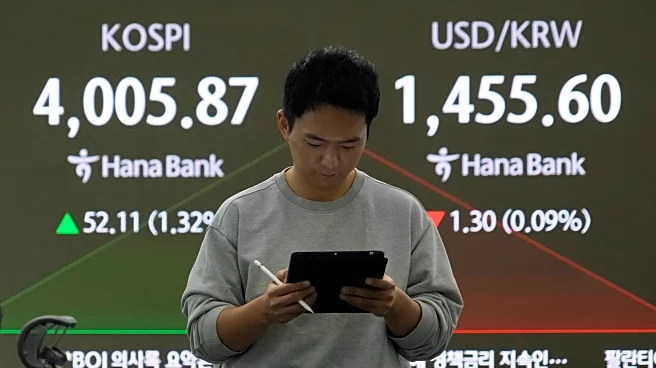What's Happening?
Asian stock markets, particularly in Japan and South Korea, experienced significant gains driven by a rebound in technology shares. The Nikkei 225 in Japan rose by 1.3%, while South Korea's Kospi increased
by 3.0%, led by semiconductor companies like SK Hynix and Samsung Electronics. This positive trend followed signs of progress in Washington towards resolving the U.S. government shutdown, which has been ongoing for about 40 days. The shutdown's potential resolution has lifted global risk appetite and U.S. equity futures, contributing to the rally in Asian markets.
Why It's Important?
The progress towards ending the U.S. government shutdown is crucial as it has disrupted economic reporting and affected market sentiment globally. The shutdown's resolution could stabilize markets and reduce policy uncertainty, benefiting industries reliant on U.S. economic data. The rebound in technology shares, particularly those linked to AI and semiconductor manufacturing, highlights the sector's resilience and its importance in driving market gains. Investors are refocusing on the demand for AI infrastructure, which could sustain the semiconductor upcycle.
What's Next?
The U.S. Senate's procedural vote advancing a funding package is a step towards reopening the government, but the bill still requires approval from the House. If passed, it could unlock delayed U.S. macroeconomic releases, providing clearer indicators for rates and growth. Additionally, the demand for Nvidia's next-generation AI chips could further influence the semiconductor market, with updates from key suppliers being crucial for assessing the AI hardware cycle's durability.
Beyond the Headlines
The rally in Asian markets underscores the interconnectedness of global economies, where developments in U.S. policy can have far-reaching impacts. The focus on AI and semiconductor stocks reflects broader trends in technology investment and the importance of innovation in driving economic growth. The situation also highlights the potential volatility in markets when heavily concentrated sectors experience shifts in sentiment.













